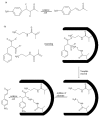Molecularly imprinted polymers: present and future prospective
- PMID: 22016636
- PMCID: PMC3189760
- DOI: 10.3390/ijms12095908
Molecularly imprinted polymers: present and future prospective
Abstract
Molecular Imprinting Technology (MIT) is a technique to design artificial receptors with a predetermined selectivity and specificity for a given analyte, which can be used as ideal materials in various application fields. Molecularly Imprinted Polymers (MIPs), the polymeric matrices obtained using the imprinting technology, are robust molecular recognition elements able to mimic natural recognition entities, such as antibodies and biological receptors, useful to separate and analyze complicated samples such as biological fluids and environmental samples. The scope of this review is to provide a general overview on MIPs field discussing first general aspects in MIP preparation and then dealing with various application aspects. This review aims to outline the molecularly imprinted process and present a summary of principal application fields of molecularly imprinted polymers, focusing on chemical sensing, separation science, drug delivery and catalysis. Some significant aspects about preparation and application of the molecular imprinting polymers with examples taken from the recent literature will be discussed. Theoretical and experimental parameters for MIPs design in terms of the interaction between template and polymer functionalities will be considered and synthesis methods for the improvement of MIP recognition properties will also be presented.
Keywords: HPLC; artificial receptors; catalysis; drug delivery; molecular imprinting technology (MIT); molecular recognition; molecularly imprinted polymers (MIPs); sensors; solid phase extraction.
Figures








Similar articles
-
Recent Advances in Molecularly Imprinted Polymers for Antibiotic Analysis.Molecules. 2023 Jan 1;28(1):335. doi: 10.3390/molecules28010335. Molecules. 2023. PMID: 36615529 Free PMC article. Review.
-
[Recent advances in applications of fragment/dummy molecularly imprinted polymers].Se Pu. 2021 Feb;39(2):134-141. doi: 10.3724/SP.J.1123.2020.08008. Se Pu. 2021. PMID: 34227346 Free PMC article. Chinese.
-
Preparation and Application of Molecularly Imprinted Polymers for Flavonoids: Review and Perspective.Molecules. 2022 Oct 29;27(21):7355. doi: 10.3390/molecules27217355. Molecules. 2022. PMID: 36364181 Free PMC article. Review.
-
[Application of novel quantum dot-based molecularly imprinted fluorescence sensor in rapid detection].Se Pu. 2021 Aug;39(8):775-780. doi: 10.3724/SP.J.1123.2021.02025. Se Pu. 2021. PMID: 34212579 Free PMC article. Review. Chinese.
-
Molecularly Imprinted Polymers in Electrochemical and Optical Sensors.Trends Biotechnol. 2019 Mar;37(3):294-309. doi: 10.1016/j.tibtech.2018.08.009. Epub 2018 Sep 18. Trends Biotechnol. 2019. PMID: 30241923 Review.
Cited by
-
Electrochemical Impedance Spectroscopy-Based Microfluidic Biosensor Using Cell-Imprinted Polymers for Bacteria Detection.Biosensors (Basel). 2024 Sep 18;14(9):445. doi: 10.3390/bios14090445. Biosensors (Basel). 2024. PMID: 39329820 Free PMC article.
-
Biomolecular Fishing: Design, Green Synthesis, and Performance of l-Leucine-Molecularly Imprinted Polymers.ACS Omega. 2023 Mar 1;8(10):9179-9186. doi: 10.1021/acsomega.2c05714. eCollection 2023 Mar 14. ACS Omega. 2023. PMID: 36936318 Free PMC article.
-
Enhancement of Electrochemical Detection of Gluten with Surface Modification Based on Molecularly Imprinted Polymers Combined with Superparamagnetic Iron Oxide Nanoparticles.Polymers (Basel). 2021 Dec 27;14(1):91. doi: 10.3390/polym14010091. Polymers (Basel). 2021. PMID: 35012114 Free PMC article.
-
SARS-CoV-2 virus label-free electrochemical nanohybrid MIP-aptasensor based on Ni3(BTC)2 MOF as a high-performance surface substrate.Mikrochim Acta. 2022 Jul 19;189(8):287. doi: 10.1007/s00604-022-05357-8. Mikrochim Acta. 2022. PMID: 35852630 Free PMC article.
-
Application of molecularly imprinted polymers in wastewater treatment: a review.Environ Sci Pollut Res Int. 2015 Jan;22(2):963-77. doi: 10.1007/s11356-014-3599-8. Epub 2014 Oct 5. Environ Sci Pollut Res Int. 2015. PMID: 25280502 Review.
References
-
- Takagishi T, Klotz IM. Macromolecule-small molecule interactions; introduction of additional binding sites in polyethyleneimine by disulfide cross-linkages. Biopolymers. 1972;11:483–491. - PubMed
-
- Wulff G, Sarhan A. Use of polymers with enzyme-analogous structures for the resolution of racemates. Angew Chem Int Ed. 1972;11:341–342.
-
- Mosbach K, Ramström O. The emerging technique of molecular imprinting and its future impact on biotechnology. Nat Biotechnol. 1996;14:163–170.
-
- Whitcombe MJ, Alexander C, Vulfson EN. Smart polymers for the food industry. Trends Food Sci Technol. 1997;8:140–145.
-
- Yan S, Fang Y, Gao Z. Quartz crystal microbalance for the determination of daminozide using molecularly imprinted polymers as recognition element. Biosens Bioelectron. 2007;22:1087–1091. - PubMed
Publication types
MeSH terms
Substances
LinkOut - more resources
Full Text Sources
Other Literature Sources

